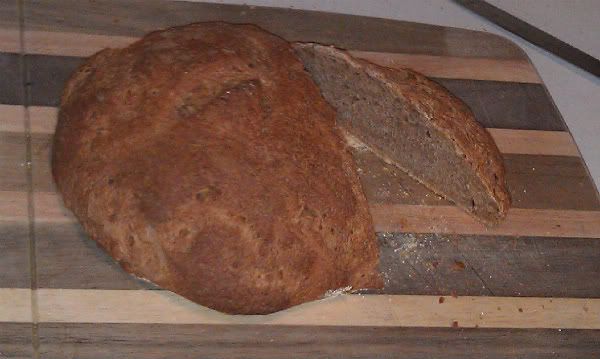13Mar
 I finally got a chance to bake some bread tonight after making a bunch of pizza over the weekend for my family.
I finally got a chance to bake some bread tonight after making a bunch of pizza over the weekend for my family.
I don’t even like coffee, but I actually love the smell and if you throw in some ice and a little sugar I can be convinced to drink a glass or two. Anyway, I was all set to make an adaptation of a bread I discovered on the internet called a Hawaiian Sour Dough when I realized I didn’t have enough starter or all of the ingredients necessary to make this bread. Instead I decided to put our new Keurig to good use and brewed some Mudslide flavored coffee. I added this in place of most of the water in my recipe along with my sour dough starter, rye flours, spelt flour and some wheat germ. For good measure I added some carmelized onions that I had left over from my barbecue pizza and also used some pistachio oil I had bought a little while ago. I thought the nutty oil would go well with the rye flours and flavorful coffee.
I do have to admit that the dough smelled amazing before it went into the oven from the mudslide coffee and hopefully when I cut into the loaf tomorrow morning it will taste even better.
Ingredients
15.5 ounces 65% Hydration Starter Refreshed
11 oz. Coffee cooled to 90 degrees F. (I used Mudslide flavored coffee)
4 oz. water (90 degrees F.)
9 ounces First Clear Flour (or strong bread flour)
4 ounces White Rye Flour
4 ounces Pumpernickel Flour
2 ounces Spelt Flour
1 ounce Wheat Germ
2.5 ounces Carmelized Onions
2 1/2 Teaspoons Sea Salt
1 Tablespoon Pistachio Oil
Directions
Using your stand mixer or by hand, mix the coffee and water with the starter to break up the starter.
Add the flours, salt, oil, and onions and mix on the lowest speed for 2 minutes. Let rest for 5 minutes
Mix for 4 minutes more on medium speed, adding more flour if necessary to produce a slightly sticky ball of dough.
Remove dough to your lightly floured work surface and need for 1 minute and form a ball.
Leave uncovered for 10 minutes.
Do a stretch and fold and form into a ball again and cover with a clean moist cloth or oiled plastic wrap.
After another 10 minutes do another stretch and fold and put into a lightly oiled bowl that has enough room so the dough can double overnight.
Leave the covered dough in your bowl at room temperature for 1.5 to 2 hours and then put it in your refrigerator overnight or up to 3 days.
When ready to bake the bread, take the bowl out of your refrigerator and let it rest at room temperature for 2 hours. After 2 hours shape the dough as desired being careful not to handle the dough too roughly so you don’t de-gas it. Place it in your bowl, banneton or shape into baguettes.
 L
L
Let it sit at room temperature for 2 hours covered with oiled plastic wrap or a wet cloth.
Pre-heat oven with baking stone (I use one on bottom and one on top shelf of my oven), to 500 degrees F.
Slash loaves as desired and place empty pan in bottom shelf of oven.
Pour 1 cup of very hot water into pan and place loaves into oven.
Lower oven to 450 Degrees and bake for 25 – 35 minutes until bread is golden brown and internal temperature reaches 200 degrees.
Let cool on cooling rack and enjoy!
The final dough had a nice subtle rye flavor with some sour undertones. You don’t really taste the coffee flavor very much and the crumb was a little tighter than I would have liked. Overall the bread was a success and is worth making again.
Please visit the Yeast Spotting Site here: http://www.wildyeastblog.com/category/yeastspotting/ for lots of cool recipes





























